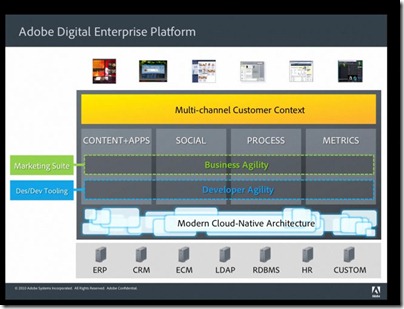When Adobe announced a shift in its business strategy in November, it was not clear what the implications were for the products that were no longer favoured. Since then bits of information have dripped out, presumably as the company itself works out its priorities. In December developers learned that Flash Catalyst would be discontinued and Flash Builder would have features removed. Now VP Arun Anantharaman has posted about what is happening to LiveCycle, the Enterprise Services side of Adobe.
Quick summary: Anantharaman says that the following “core offerings” will be the subject of continuing investment:
- Modules: Reader Extensions, Forms, Output, Digital Signatures, Rights Management, Process Management, PDF Generation
- Tools: Workbench, Designer
- Solutions: Correspondence Management
- ECM Connectors: SharePoint, IBM Filenet, Documentum
- Advanced Offerings: Data Services
While it is reassuring to see that Data Services will not be abandoned, and that the most important PDF-based server products still have a future, not everything is clear regarding Adobe’s enterprise strategy. It is telling that Anantharaman’s post is entitled “The Future of LiveCycle”; yet the LiveCycle product page still says that LiveCycle has been replaced by the Adobe Digital Enterprise Platform:
The next evolution of LiveCycle is here. The new Adobe Digital Enterprise Platform (ADEP) brings together core LiveCycle capabilities and much more.
So why not a post on the future of ADEP? If you look at the FAQ about ADEP it seems that many of the modules mentioned above have been replaced by ADEP services.
It would also be helpful to spell out exactly what is being dropped, rather than leaving customers to work this out by spotting what is not mentioned. It does appear that the work Adobe has done on composite applications (“Mosaic”) is a casualty. Collaboration services are another obvious omission. Correspondence seems to be the sole survivor from what was three Solutions Accelerators: the other two were “Review and Approval” and “Interactive Statements”.
There is also the question of what is happening with Adobe’s Enterprise Content Management story. In October 2010, Adobe completed its acquisition of Day Software, thereby acquiring REST pioneer Roy Fielding as well as Day’s core product, CQ (Communiqué). ADEP seemed to bring together the CRX content repository which is used by CQ with Adobe’s previous investment in Enterprise application development, as well including the PDF document services that go back many years at Adobe, before the Macromedia acquisition.
Now, Web Content Management is still a focus at Adobe, being part of what Adobe, with its love of the Experience word, calls Web Experience Management. This is from Anantharaman’s statement last November:
we are now planning to focus our Enterprise efforts on products targeting the digital marketer, including the Digital Marketing Suite and Web Experience Management solution.
That suggests CQ and CRX are alive and well at Adobe; but what exactly is happening to ADEP?
I have asked Adobe for clarification of its Enterprise strategy, and while nobody was available to speak to me on the subject immediately, I have been told that this should be possible in a couple of weeks time, so watch this space.
